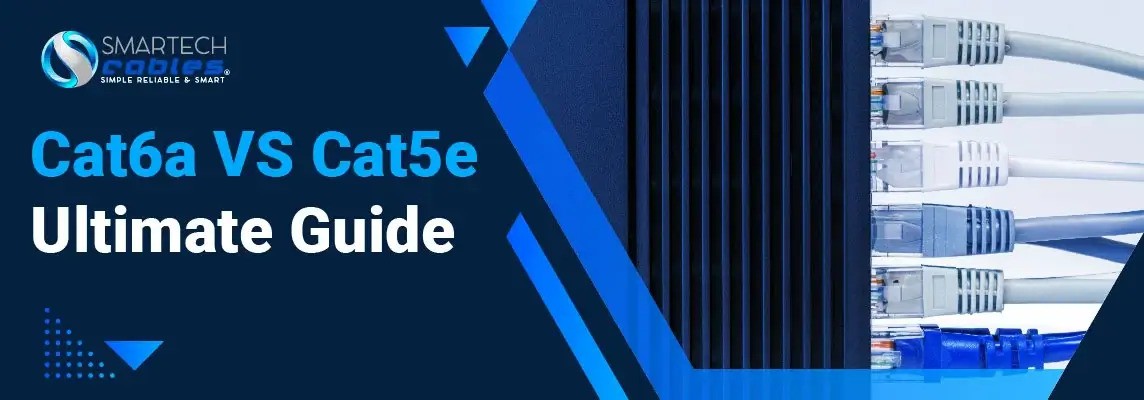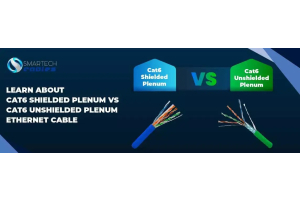Cat6a vs Cat5e: Ultimate Guide

You have probably wondered about the difference between Cat6 and 6a ethernet cables, but have you ever wondered how the Cat5e ethernet Cable differs from the Cat6a? Well, probably you have that is why you are here. Anyway, Cat6a and the Cat5e cable differ from one another. Both cables are also similar in over one factor.
Cat5e is the enhanced category 5 of ethernet cables, whereas the 1000ft Cat6a cable is the augmented category 6. Both of the cables have unique performance features and therefore have different applications.
Enhanced Category 5 cable was introduced earlier than the Cat6a cable 1000ft. Therefore, the latter is more able and high-performing. Not that the Cat5e cable is outdated or underperforming, it's just not as good as the Cat6a ethernet cable.
This is your ultimate guide to the differences between the bulk Cat6a and Cat5e ethernet cables. Be sure to read it.
Cat5e Cable: Specifications
The Cat5e Ethernet cable can be divided into two parts. The core and the outermost. At its core, it has conductors and metal foil or wire mesh shielding in shielded cables. The outermost part of the cable has the jacket. It insulates the core of the environment and ensures the proper functionality of the cable. The jacket is ideally made from a water-resistant and flexible material.
Now, the conductors are 8 in number and are twisted into pairs, making 4 twisted pairs at the core. Why do you reckon the conductors are twisted? Well, EMI and Crosstalk. EMI (electromagnetic interference) and crosstalk are two of the most common hurdles in the smooth and efficient transfer of data. To tackle this issue, the conductors are tightly twisted in pairs, which minimize EMI and Crosstalk (both Near End and Alien).
Cat5e Cables
Cat5e Cables are produced in many variants. These cables offer more options to choose from, as compared to the bulk Cat6a cables. Following are the Cat5e cables:
- Cat5e Plenum UTP/STP Solid Copper
- Cat5e Plenum UTP/STP Stranded Copper
- Cat5e Riser UTP/STP Solid Copper
- Cat5e Riser UTP/STP Stranded Copper
- Cat5e Plenum STP Solid CCA
All the above-mentioned Cat5e cables can support a 100 MBit/s data transfer rate at up to 100 meters. Over 50 meters, the transmission speed reaches up to 1 GBit/s. These cables can also be used for PoE applications. Except for the Cat5e with the CCA conductors.
Also pertinent to mention here is the fact that Cat5e Ethernet Cables are produced in more types than those mentioned above. For example, all the above bare copper Cat5e cables are also produced with CCA conductors. Which makes the options twice as much as the Cat6a. However, the CCA conductors are not reliable for many applications and they overheat in high-performance use.
Pro Tip: Never use the CCA cables for PoE. They wear out quickly and are a fire hazard.
Cat6a Cable Specifications
Cat6a Ethernet Cable is by far superior to Cat5e. There is no confusion about that. But Cat5e cable is ideal for specific uses. More on that later.
Cat6a is one of the latest Ethernet cable categories. It has a whopping 10 GBit/s data transfer rate at 100 meters. This makes it ideal for the 10BASE-T networks. The cable can also be used for 1000BASE-T applications, which stipulates that it should have up to 1 GBit/s data transfer rate over 100 meters.
The 1000ft Cat6a cable conductors are also twisted more tightly than the Cat5e’s. Tighter twists mean even lesser EMI and crosstalk in data transmission. The conductors of the cable are only made from solid and stranded pure copper. The jackets are made from the riser and plenum-rated materials only.
You might have noticed by now that the Cat6a cables are made only from the most premium quality materials. That is true and it ensures the high performance of the cable. The cable is designed for applications in commercial and residential networks with a stellar performance requirement, and these cables fit that need perfectly.
Cat6a Cables
When it comes to buying the Bare copper Cat6a cables, the choices are quite limited. Since the cables are produced from only limited types of materials, the types of cables are also limited. Following are the variants of Cat6a Cables:
- Cat6a Plenum STP/UTP Solid Copper
- Cat6a Riser STP/UTP Solid Copper
- Cat6a Plenum STP/UTP Stranded Copper
- Cat6a Riser STP/UTP Stranded Copper
Cat5e vs Cat6a: Difference
Cat5e was rolled out much earlier than the Cat6a cable. It was ideal for the most commonly used applications at the time. But when the Cat6a cable was introduced, the networking requirements were much more advanced, and it has to cater to those.
So, the Cat6a cable 1000ft has a much faster data transmission rate than the Cat5e. Additionally, it has a better resistance against crosstalk and interference because of its design which includes a spline/wire separator to separate the conductor pairs.
Cat5e & Cat6a Cable Similarities?
The similarities between the Cat5e and 6a Cables are few. The most basic similarity is the standard. Cat6a and the Cat5e cables are standardized to have twisted pair conductors by the IEEE. Although the gauges of the wires are different, they both feature twisted-pair wires.
Moreover, the Cat5e and 6a cables have the same run length for their base performance. At 100 meters, both cables should deliver their standard performance which is up to 100 MBit/s and 10 GBit/s, respectively.
Uses of Cat5e Cable
As mentioned earlier, Cat5e was the best of its kind when it first came out. It was used in all kinds of settings. Even today, it is still being used in both residential and commercial applications. The degree to which these cables are used varies, but they are used nevertheless.
Residential Networks: In residential networks, such as in apartment buildings or homes, the cables make excellent LAN networks. At quite an affordable price, these cables provide decent performance which suffices for home applications such as video streaming, online gaming, IP security cameras, etc.
Commercial Networks: in commercial networks such as in offices, schools, and other kinds of business centers, the Cat5e is used. However, if the requirements of the commercial networks are too much, the Cat5e may not suffice, which leads us to the next option.
Uses of Cat6a Cable
Cat6a cable, with its 10-gigabit transmission speed and 750 MHz bandwidth, suffices for all ethernet applications.
Residential: residential networks do not require exceptionally high performance. If the Cat5e cable can be used for this application, Cat6a can also be used. But to put it logically, the Cat6a ethernet cable has the ideal features for use in residential settings.
Commercial: In commercial networks, the Cat6a cable performs superior to any other cable. Its performance is unmatched and caters to all sorts of devices and protocols. Whether you need to use it for PoE devices or any other sort, this cable is a perfect choice.
Data Center: In data centers and server rooms, network cables are run at close lengths. Even within a few inches because the server and other devices need only to be connected. So, the bulk Cat6a cable is ideal for use in such settings. Because first, it has a high bandwidth capacity and data transfer rate, and second, its performance can further be strengthened when it is run at short lengths.
Cat5e or Cat6a: Which one do I need?
Although both of these cables are decent solutions for a multitude of options, they do have their unique use.
For example, the Cat5e cable can also support gigabit data transfer rates, but it is not ideal for data centers. Because it does not have those measures against EMI and crosstalk that the Cat6a cable has.
So, you will need the Cat6a ethernet cable for any application which requires gigabit or 10-gigabit speed. And for other applications such as for home LAN networks, the Cat5e cable is an ideal choice and will make do perfectly.
Does Shielding Matter?
Shielding is the protective wire mesh or metal foil wrapped around the cable conductors. It is a shield, and it protects the cable against interference coming from other cables in a cable tray or duct.
Shielding in Cat6a and Cat5e cables matters. And in all ethernet cables as well. Shielding ensures a smooth flow of data and better signal integrity. Shielded Cat6a and 5e cables relay a signal far stronger than their unshielded counterparts.
Smartech Cables
For innovative ethernet cables or accessories, check out Smartech Cables. We are the industry leader in manufacturing and distributing networking cables and accessories of the highest standards. Our products exceed the industry standards and we are offering competitive market prices. If you need help, our professional customer support team is available at sales@smartechcables.com.






